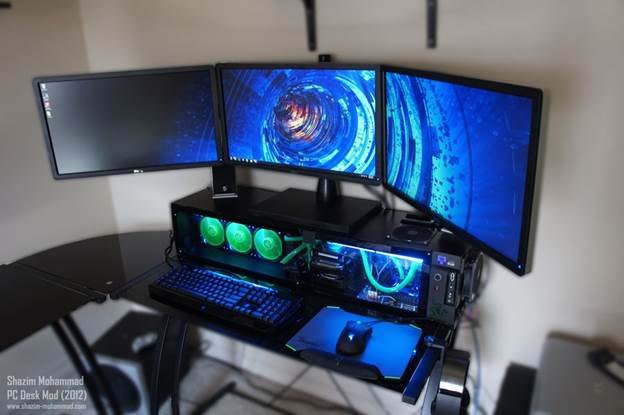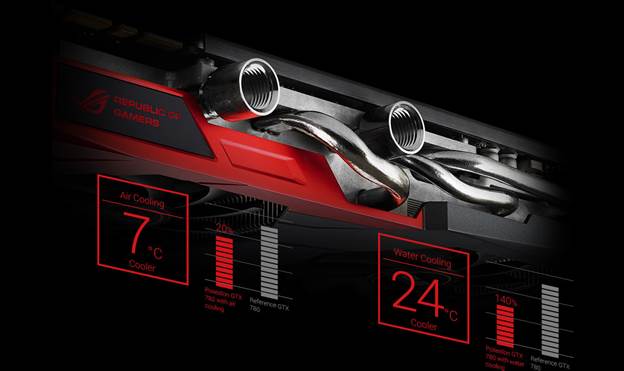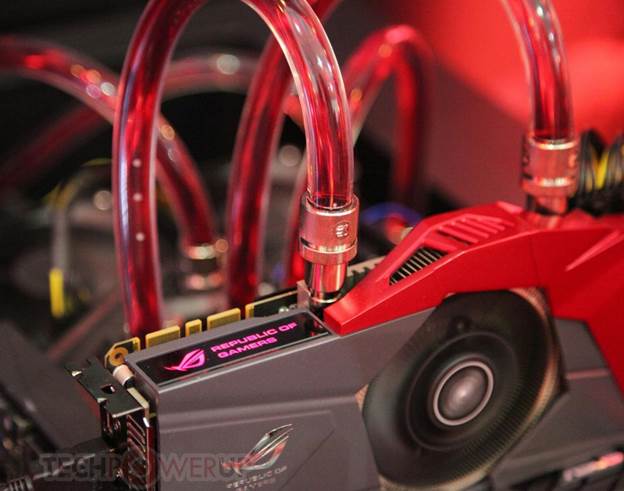Take the mystery out of water-cooling with ASUS’s dedicated,
liquid-cooling ready hardware

The system
contains an Intel Core i5-2500k Processor with an Asus Gene IV Motherboard, AMD
Radeon HD 7950 Graphics card, 3 x Dell Ultra Sharp 23inch monitors
, liquid cooling system, and more.
Water Boarding
Another prime heat creator in today’s PCs are the power
components found on the motherboard, such as the MOSfets and chokes. These get
especially hot when the motherboard is used to overclock the CPU, as their
workload is increased massively, even with just minor power increases to the
CPU socket. Installing water cooling on these power components is very
difficult, as each motherboard’s layout is totally different to the next,
making it hard to find water blocks that fit perfectly.
Once again ASUS comes to the rescue with its unique
CrossChill cooling solution, which is found exclusively on ASUS Republic of
Gamer motherboards such as the Maximus VI Formula. Like the Poseidon graphics
card, the use of the CrossChill cooling solution is entirely optional; the
motherboard will work perfectly without this cooler being plugged into a water
cooling system, as the cooling blocks work acceptably using air. However, it’s
only when the CrossChill block is plugged into a water cooling pump and
radiator that it can flex its muscles.

The new Z87
chipset based ROG Formula motherboard comes with
the latest CrossChill Cooling technology and features ROG armor.
Testing shows that CrossChill decreases the average
operating temperature of the motherboard’s power components by a whopping 23C.
Not only does this make the motherboard more stable and improve the lifespan of
the components, it proves to be even more important when the CPU is
overclocked. Look inside any overclocked PC and it’s easy to feel the heat
radiating from the power components surrounding the CPU socket, but CrossChill
safely removes this, with the added benefit of remaining whisper-quiet in the
process. The CrossChill features the state of the art water cooling design
based on a single piece water channel, while the additional heatsink fins helps
to capture the airflow in the surrounding to ensure every chance of heat
dissipation capability is put to best use. Lab testing has proven that even
after three years of continuous use there is barely any rust, unlike many
competing power water blocks. Once again CrossChill also uses the same G1/4”
connections as the Poseidon cooler, allowing for a wide range of compatibility
with other water cooling products.

ASUS Poseidon
(yes, it's a GTX770). Pretty interesting design. Will definately save you some
money if you chose to go liquid cooling later on (no need to buy a waterblock).
While the user will still need to install a radiator and
pump when using CrossChill and Poseidon, the entire process is much simpler
than usual, as the hard parts have already been done. These two products are
the perfect introduction to water cooling for those who are concerned about the
complexity of the job, and don’t want to void their warranties in the process.
Get ready to experience the power of water with ASUS, without all the fuss.